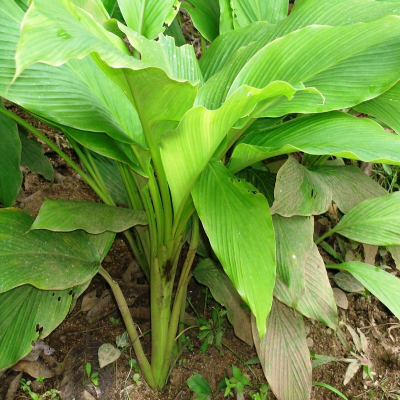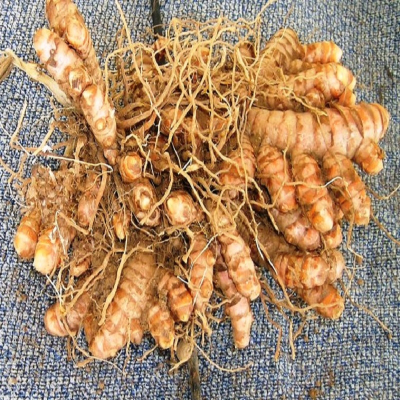Distribution and Habitat: It is the most important member of genus Curcuma. Turmeric is a perennial herb and cultivated all over India, particularly in West Bengal, Tamil Nadu and Maharashtra. Turmeric occupies an important position in the life of Indian people as it forms an integral part of the rituals, ceremonies and cuisine.
Botany: It is a perennial herb, 60-90 cm in height, with a short stem and tufts of erect leaves.
- Leaves: Simple, very large, petiole as long as the blade, oblong-lanceolate, tapering to the base upto 45cm long.
- Flowers: Pale yellow, arranged in spikes concealed by the sheathing petioles and flowering bracts are pale green
- Rhizome: Cylindric, ovoid, orange coloured and branched.
Properties: Rhizome is antiprotozoal, spasmolytic, Neuro tonic, antiparasitic, antispasmodic, antibacterial, antiarthritic, anthelmintic, carminative, antiperiodic, emollient, anodyne, laxative, diuretic, expectorant, alterative, alexeteric, febrifuge, opthalmic and tonic.
Chemical constituents: It contains turmerone, and curcumene as major constituents. Some of the other compounds of oil are a-and b-pinene, sabinene, myrcene, a-terpinene, limonene, p-cymene, perillyl alcohol, turmerone, eugenol, isoeugenol, eugenol methyl ether and isoeugenol methyl ether.
Curcumin and related compounds have also been reported as major constituents of the rhizomes. Recently a number of sesquiterpenes have been reported from C. longa, viz., the sesquiterpenoids of germacrane, bisabolane and guainane skeletons. The study of sesquiterpenes has revealed a new compound curlone. The crystalline colouring matter curcumin (0. 6%) is diferuloyl methane. Stigmasterol, cholestrol, b-sitosterol and fatty acids, mainly straight chain dienoic acids are reported. Curcumin, the colouring agent and major constituent of C. longa, is said to possess local as well as systemic anti-inflammatory property which has been found to compare favourably with phenylbutazone. An extract of the crude drug ‘akon’ containing the rhizomes exhibited intensive preventive activity against carbon tetrachloride induced liver injury invivo and invitro. The liver protecting effects of some analogs of ferulic acid and p-coumaric acid, probable metabolites of the curcuminoids have been also evaluated. Curcumin is anti-inflammatory.
Uses: Due to the strong antiseptic properties, turmeric has been used as a remedy for all kinds of poisonous affections, ulcers and wounds. It gives good complexion to the skin and so it is applied to face as a depilatory and facial tonic. The drug cures diseases due to morbid vata, pitta and kapha, diabetes, eye diseases, ulcers, oedema, anaemia, anorexia, leprosy and scrofula.
Formulations: Haidra khand
Agrotechnology
Soil and climate: Turmeric is a tropical herb and can be grown on different types of soils both under irrigated and rainfed conditions. Rich loamy soils having good drainage are ideal for the crop
Propagation: The plant is propagated by whole or split mother rhizomes. Well developed, healthy and disease free rhizomes are to be selected. Rhizomes are to be treated with copper oxychloride fungicides and stored in cool, dry place or earthen pits plastered with mud and cowdung. The best season of planting is during April with the receipt of pre-monsoon showers. Beds of size 3x1.2m with a spacing of 40 cm between beds are to be prepared. Small pits are to be taken in the beds in rows with spacing of 25-40 cm. Finger rhizomes are to be planted flat with buds facing upwards and covered with soil or dry powdered cattle manure. The crop is to be mulched immediately after planting and 50 days after first mulching.
Varieties: Duggirala, Tekurpetta, Sugantham, Kodur, Suvarna, Suguna, Sudarshana
Manuring: Cattle manure or compost is to be applied as basal dose at 20-40t/ ha at the time of land preparation or by spreading over the beds after planting. Apply NPK fertilizers at 30:30:60 kg/ ha. Full P and half K as basal, two-third N at 30 days after planting and the remaining K and N at 60 days.
After cultivation: Weeding is to be done twice at 60 and 120 days after planting, depending upon weed intensity. Earthing up is to be done after 60 days.
Plant protection: No major incidence of pest or disease is noticed in this crop. Leaf blotch and leaf spot can be controlled by spraying bordeaux mixture or 0.2% mancozeb. Shoot borers can be controlled by spraying 0.05% dimethoate or 0.05% quinalphos.
Harvesting: Time of harvest usually extends from January-March. Harvesting is generally done at about 7-10 months after planting depending upon the species and variety. Harvested rhizomes are to be cleaned of mud and other materials adhering to them. Good fingers separated are to be used for curing.



